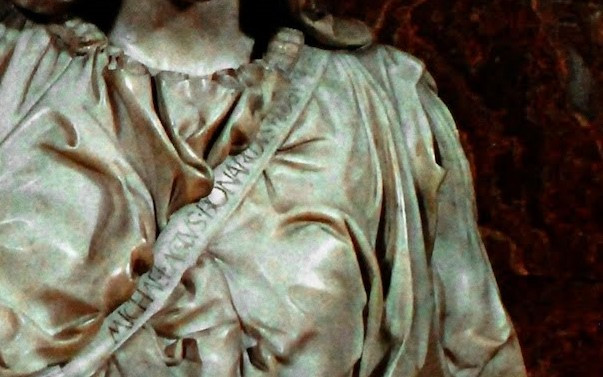JULY 19, 2020 – (Cont.) A couple of weeks—half the summer, it seemed—had passed since I’d first been made aware of The Pietà. As my uncle, mother, sister and I walked the fairgrounds, I saw many other attractions that eclipsed Michelangelo’s famous work—things such as the old-fashioned car track next to the Ford Pavilion; the Aztec pole dancers outside the Mexican Pavilion; the TV-telephones at the Bell System Pavilion. It was later in the afternoon when, after conferring with my uncle, Mother announced to my sister and me that now we’d be heading to the Vatican Pavilion to see . . . The Pietà. Oh yeah, The Pietà.
As everywhere else at the fair, we got to stand in an interminable queue—baking in summer heat and sunshine. After shuffling along like pilgrims to a shrine, we finally entered the building where The Pietà was exhibited, and after what seemed like another 1,000 baby steps, we were finally rewarded with a sighting of the top of Mary’s head, set ashine by a strategically placed display light. I remember some of the people ahead of us crossing themselves as they obtained a full view of the sculpted marble. A few steps more and we ourselves got to see the entire sculpture, top to bottom.
If my frame of reference for such a grand piece of art was quite limited, I nonetheless realized that this really was something special, quite apart from all the hype around it; a piece of work like none other I’d seen. I remember distinctly telling myself to “look very carefully,” surveying every part of the work as we were encouraged for the umpteenth time by the security guards to “keep moving.”
Once we’d cleared the exhibition space, we were shepherded into a large, crowded souvenir shop. I’d never before been in such “Catholic” space—a place filled with Marys, Jesuses, and crucifixes of all sizes and quality of molding—especially plastic, though the finer, more expensive items were made of something far more durable. There were plaques, pictures, miniature statues, not-so-miniature statues, and enough top-o-the-dashboard Jesuses for all the Catholic cars east of the Mississippi.
But the biggest space in the shop was reserved for models of . . . The Pietà. I immediately thought of Dad’s souvenir request on the eve of our departure. I burst out in glee. “Mom! Look! Models of The Pietà! Just what Dad wanted!”
Then to choose. Some factory—or factories—had punched out every imaginable size and quality model of the famous sculpture. The biggest ones were suitable for an outdoor garden of a Catholic cathedral. The smallest ones you could park on a crowded shelf of your great-aunt’s display case filled with tchotchkes from a lifetime of road trips.
I settled on a hard-plastic model about five inches high resting on a semi-circular stand with a blue, semi-circular mirror affixed to the straight side of the stand. Taking into account my budget and suitcase size, I thought it was an acceptable “model” of the real deal.
(Cont.)
(Remember to subscribe to this blog and receive notifications of new posts by email.)
© 2020 by Eric Nilsson
